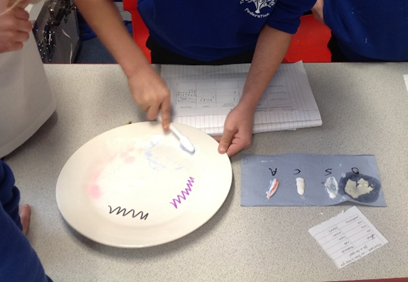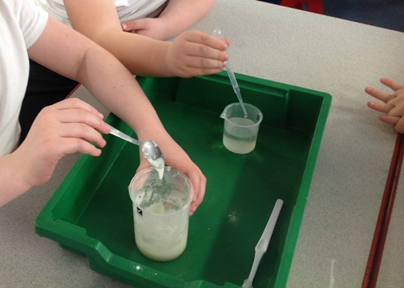Year 3
In Year 3, our focus in Science was Mary Anning in Spring 1 and rocks and fossils in Spring 2. First, the children made their own fossils and excavated using tools. We learnt how to identify igneous, sedimentary and metamorphic rocks from their physical features and this helped us to remember how each rock was formed.

 During Science Week, we explored the science of making toothpaste! We agreed that a good toothpaste should kill bacteria, have a nice scent and stay on the toothbrush! We carefully mixed ingredients to make our toothpaste. We then needed to think scientifically to plan a fair test to compare our own toothpaste to branded toothpastes. Finally, we collected the results in a tally chart and presented the results in a series of bar graphs.
During Science Week, we explored the science of making toothpaste! We agreed that a good toothpaste should kill bacteria, have a nice scent and stay on the toothbrush! We carefully mixed ingredients to make our toothpaste. We then needed to think scientifically to plan a fair test to compare our own toothpaste to branded toothpastes. Finally, we collected the results in a tally chart and presented the results in a series of bar graphs.
Year 4
Year 4 have loved learning all about electricity this term. We have been creating simple circuits out of bulbs, wires and cells and discovering the scientific symbols for each component. We even tested which switch works best in order to switch our light bulb on and off the quickest!

 More recently, the children have been using their geographical knowledge of maps and mountains alongside their scientific knowledge of electrical circuits to create electrical board games! They have put a lot of thought into the bright, eye catching design of their games and we have discussed how important it is for our “wires” (made from foil and masking tape) not to cross over so that the circuits are complete and the games work properly. The children have loved researching different mountains in Europe and then plotting them on their maps. Some of them were surprised to learn about the mountains we have in the United Kingdom!
More recently, the children have been using their geographical knowledge of maps and mountains alongside their scientific knowledge of electrical circuits to create electrical board games! They have put a lot of thought into the bright, eye catching design of their games and we have discussed how important it is for our “wires” (made from foil and masking tape) not to cross over so that the circuits are complete and the games work properly. The children have loved researching different mountains in Europe and then plotting them on their maps. Some of them were surprised to learn about the mountains we have in the United Kingdom!
Year 5
During the Spring term, Year 5 have looked in depth at Forces. The children can now explain balanced and unbalanced forces. Making links to their Autumn term learning, they know that gravity was first discovered by Sir Isaac Newton and that the measure of force is named after him, and that we can measure the force of gravity with the use of a Newton Meter.
When working scientifically, the children had fun experimenting with different types of helicopter blades to see which ones offered the greatest air resistance and so stayed in the air longer. The children were able to make a prediction, as well as draw conclusions from their findings.
They could then build on this knowledge to show their understanding about water resistance. The children enjoyed working scientifically and learnt many skills such as managing variables (controlled and independent) to keep tests fair and reliable.
 Working scientifically, the children enjoyed experimenting with how friction can act as a force, creating heat, and how this can be a hindrance or important in terms of safety. Forces were also investigated in terms of gears and pulleys.
Working scientifically, the children enjoyed experimenting with how friction can act as a force, creating heat, and how this can be a hindrance or important in terms of safety. Forces were also investigated in terms of gears and pulleys.
Year 6
This term Year 6 have been investigating the theories and scientific research around Evolution and Inheritance. We have studied Darwin’s theories on this and looked at adaptive traits (creating our own species for a given habitat) and inherited traits (how offspring might vary and why). Following Darwin’s theories we created our own experiment where we investigated how hand shape could affect an animal’s ability to eat, which the children thoroughly enjoyed.
We investigated how fossils are created (making our own) and then how these can help and expand our understanding of the evolutionary process in different species (our research into Mary Anning also supported this). With all this knowledge and understanding we then looked at how our own species has developed and evolved over time.
Our final area of research and investigation was around extinction and how many different factors can affect the animals that live, or have lived, on our planet. With the children writing a report about an animal, thought to be extinct, that has been spotted locally! Could there be hope that this species is still alive?
